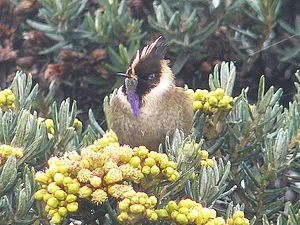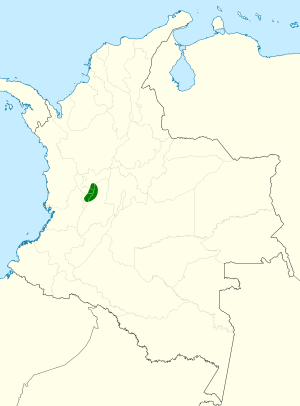Buffy helmetcrest facts for kids
Quick facts for kids Buffy helmetcrest |
|
|---|---|
 |
|
| Conservation status | |
| Scientific classification | |
| Genus: |
Oxypogon
|
| Species: |
stuebelii
|
 |
|
The buffy helmetcrest (Oxypogon stuebelii) is a special kind of hummingbird. It is known as a Vulnerable species, which means it faces a high risk of becoming extinct. This bird lives only in Colombia.
Contents
About its Family Tree
The buffy helmetcrest was once thought to be a type of bearded helmetcrest. But in 2013, scientists studied these birds closely. They looked at their size and the colors of their feathers. Based on this research, they decided that the buffy helmetcrest was unique enough to be its own species. This means it is now recognized as a separate kind of bird. The buffy helmetcrest is a "monotypic" species, meaning it does not have any subspecies.
What Does it Look Like?
The buffy helmetcrest is about 11 to 13 centimeters (4.4 to 5 inches) long. It has a short, straight, black beak.
The male bird is quite fancy! It has a long, buffy (pale yellowish-brown) and black crest on its head, like a helmet. Its face is mostly black with a buffy-white "collar" around its neck. Its back feathers are a shiny bronzy-green color. It also has a thin, sparkling green and blue "beard" under its chin. This beard is called a gorget. The rest of its belly is grayish-bronze, turning to cinnamon-buff under its tail. Its tail is medium-long and forked, like a "V" shape. The top of the tail is coppery or bronzy-green, with the outer feathers showing a wide white stripe. The underside of the tail is reddish-brown with some pale cinnamon.
The adult female looks a bit different from the male. She does not have the crest or the beard. Her belly is rufous-buff (reddish-yellow-brown) to brownish, with some greenish spots. Young birds look like the adult female. Young males will start to grow a small crest and beard.
Where it Lives and What it Calls Home
The buffy helmetcrest is found only in one special place: Nevado del Ruiz. This is an active volcano in the Andes Mountains of Colombia. It lives in the high-altitude, humid, open grasslands called páramo. It especially likes areas with Espeletia plants, which are tall, fuzzy plants found in these mountains.
How it Behaves
Where it Moves
Scientists think the buffy helmetcrest usually stays in one area. However, it might move to lower places during the dry season. This is similar to another type of helmetcrest, the white-bearded helmetcrest.
What it Eats
The buffy helmetcrest mainly eats nectar from flowers. It particularly loves the nectar from Espeletia schultzii plants. Instead of hovering, it often clings to the flowers to drink. It also eats insects and their young (larvae). It catches insects on the ground or by jumping up from the ground or a branch. It also picks larvae off plants.
How it Raises Young
Not much is known about how the buffy helmetcrest breeds or raises its young.
What it Sounds Like
The buffy helmetcrest's song is a high-pitched, single note that sounds like "tsee." It repeats this sound every 3 to 5 seconds. During the wet season, male birds will sing for many minutes from a perch.
Its Conservation Status
The IUCN (International Union for Conservation of Nature) has listed the buffy helmetcrest as a Vulnerable species. This means it is at high risk of extinction. It lives in a very small area. Even though much of its home is inside Los Nevados National Park, its páramo habitat outside the park is being destroyed quickly. Scientists believe there are fewer than 1,000 adult buffy helmetcrests left, and their numbers are decreasing.
See also
 In Spanish: Oxypogon stuebelii para niños
In Spanish: Oxypogon stuebelii para niños


